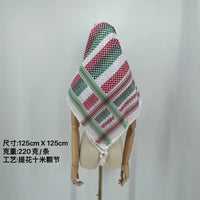The keffiyeh, a traditional Middle Eastern scarf, has become a symbol of cultural identity, resistance, and solidarity. This article explores the various meanings and historical significance of wearing the keffiyeh, particularly in the Palestinian context.
Origins and Historical Significance
The keffiyeh, also known as a kufiya, shemagh, or hattah, is a square-shaped cotton or wool scarf with a distinctive fishnet pattern. Its origins can be traced back to ancient Mesopotamia, where it was worn by Babylonians and Sumerians. The term "keffiyeh" is derived from the city of Kufa in Iraq, highlighting its deep historical roots.
In the harsh desert climates of the Middle East, the keffiyeh served a practical purpose, protecting wearers from the sun, dust, and sand. It was commonly worn by Bedouins and rural farmers, known as fellahin, who relied on it for daily protection. However, its significance evolved over time, particularly in the Palestinian context.

Symbol of Palestinian Identity and Resistance
In the 1930s, the keffiyeh became a potent symbol of Palestinian identity and resistance. During the Arab revolts against British rule, Palestinian rebels adopted the keffiyeh to conceal their identities and blend in with the general population. The British authorities attempted to ban the keffiyeh, but this only strengthened its symbolic value. Palestinians from all social backgrounds began wearing it as a form of collective resistance.
The keffiyeh's association with resistance was further solidified in the 1960s when Palestinian guerrilla fighters, known as feda'iyin, and political leader Yasser Arafat popularized it globally. Arafat's iconic image, with the keffiyeh draped over his shoulder, became synonymous with the Palestinian struggle for independence. When Israeli authorities banned the Palestinian flag in 1967, the keffiyeh emerged as a de facto symbol of Palestinian nationalism.
Patterns and Symbolism
The patterns on the keffiyeh carry deep cultural significance. The fishnet pattern is often interpreted as representing the Palestinians' connection to the sea, while the bold lines symbolize trade routes that historically made Palestine a hub of exchange. The oval stitches along the borders represent olive tree leaves, a symbol of resilience and attachment to the land. Olive trees play a vital role in the Palestinian economy and culture, representing both sustenance and steadfastness.

Cultural Appropriation and Commercialization
As the keffiyeh gained global recognition, it also faced issues of cultural appropriation and commercialization. Mass manufacturers began producing keffiyehs for fashion purposes, often disregarding their cultural and political significance. This led to accusations of cultural appropriation, as seen with brands like Topshop and Urban Outfitters, which marketed keffiyeh-inspired items without acknowledging their historical context.
For Palestinians, the keffiyeh remains a powerful symbol of cultural identity and resistance, despite its commercialization. It is crucial to support authentic keffiyeh products from Palestinian or Arab-owned businesses to preserve its cultural integrity.

Conclusion
Wearing the keffiyeh is more than a fashion statement; it is a symbol of cultural identity, resistance, and solidarity. Its historical significance, particularly in the Palestinian context, underscores its value as a representation of resilience and unity. As the keffiyeh continues to be worn globally, it is essential to respect its origins and support authentic sources to honor its cultural and political significance.





